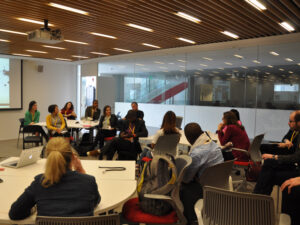
Innovation in Peacebuilding:
Taking Advantage of Affordances
A few days ago, Melissa Mannis of the newly formed Peace Innovation Initiative (PII) at the UN University of Peace asked me to send her something I’d written for her board of directors to take a look at. I quickly realized that I didn’t have anything that directly fit what she was asking for and rather than doing a lot of cutting and pasting, I decided to write something fresh about the role(s) innovation in general and new technology in particular could and should play in peacebuilding .
What came out was a classic bad news/good news story.
But one with a historical twist that could help PII and others I work with recenter and redefine their work.
Like many of us, Melissa and her team tend to equate innovation with the use of new technologies. While the two almost always go hand in hand, it’s important to see that they are not the same thing and that if we start with technology rather than the broader idea of innovation, we open the door to some of the worrisome ways that the Silicon Valleys of the world have evolved in recent years
If, on the other hand, we focus more on the so-called affordances the new technologies offer us, it is easy to see not only what could be done by peacebuilders who think explicitly in terms of innovation but also what some of them are already doing.
And we don’t necessarily have to take on big tech and its excesses head on to take advantage of those affordances.
Rather, we can mostly use existing technologies and repurpose them to suit peacebuilding and related goals by taking advantage of their affordances or the new things that they allow us or enable us to do.
The Bad News
 But the bad news first.
But the bad news first.
You don’t need me to tell you that technological issues feature prominently on the lists of what’s wrong with social and political life these days. Just recall three of the themes which appeared in last week’s Next Big Idea Club Podcast in which Steven Johnson and Eli Pariser discussed the implications of Elon Musk’s planned purchase of Twitter:
- Rising inequality. They were most troubled by the fact that the world’s richest man is in the process of gobbling up one of the leading social media platforms. In so doing, he will add to the growing concentration of wealth that is true not just of the IT space but of our economies in general.
- Toxic polarization. You would have to be living on some other planet to not know about the ways social media platforms (and not just Twitter) and their algorithms have deepened the divides among Americans and people in most other countries around the world.
- Surveillance capitalism. On the other hand, you could be excused if you hadn’t been paying attention to the way those same platforms and algorithms give the various “big siblings” of the world more and more information about what we are like as people. Often without our knowledge. And despite the best efforts of the European Union and others to limit what big companies and governments can do with our data.
I could add more items to the list, but I don’t want to depress either you or my friends at PII more than I absolutely have to!
Historical Perspectives
There are advantages to being old. Not the least of them is that I can put worrisome trends like these in a broad enough historical perspective to see that there are alternatives to the status quo which organizations like PII and others I work with could and should promote. In the interests of brevity, I’ll limit myself to three turning points in my life that have pointed me in a much more optimistic direction than Pariser and Johnson, who are among the observers I’ve turned to the most in recent years when I have thought and written about either innovation or technology.
 The first Build Peace conference. I’ll start with the most recent. On April 4, 2015, I walked into the MIT Media Lab for the first Build Peace conference that explored the relationship between peacebuilding, technology, and the arts. I only knew three of the 200 or so people there. I was also by far the oldest person in the room. Seven years later, I’m on their board of directors and getting ready for this year’s conference in Chemnitz, Germany. What’s relevant here is that for those two days in Cambridge, we all talked about all the positive affordances new technologies could bring to peacebuilding. Even Facebook. And Twitter.
The first Build Peace conference. I’ll start with the most recent. On April 4, 2015, I walked into the MIT Media Lab for the first Build Peace conference that explored the relationship between peacebuilding, technology, and the arts. I only knew three of the 200 or so people there. I was also by far the oldest person in the room. Seven years later, I’m on their board of directors and getting ready for this year’s conference in Chemnitz, Germany. What’s relevant here is that for those two days in Cambridge, we all talked about all the positive affordances new technologies could bring to peacebuilding. Even Facebook. And Twitter. - The Well and Beyond War. I just finished John Markoff’s remarkable biography of the remarkable Stewart Brand who has had so much to do with the rise of digital technology and culture. To cite but one example, he coined the term personal computer. While reading, I found myself transported back to the 1980s and one of Brand’s early inventions, The WELL (for Whole World ‘Lectronic Link), which was one of the first attempts to use the Internet (before the invention of the World Wide Web) for social change. In Beyond War, we used it and other early platforms to send emails (earth shattering at the time) so our distributed team could stay connected. We did televised speacebridges with Soviets. We developed curricula which we distributed on video tape cassettes which were the 1980s equivalents of streaming video. We Gophered and Fetched files. We reveled in this brand new thing called the World Wide Web, and many of us even learned to code HTML. We didn’t get everything right, of course. A few years later, I even gave a talk to some advanced placement teachers about why Lynx browser was all we would ever need and that its graphic based competitors like Mosaic were just a flash in the pan. Even though I got that one wrong by orders of magnitude, my friends at Beyond War, Brand, and the other pioneers opened the door to a wealth of possibilities.
 Computing comes to Oberlin. I was introduced to computers when Oberlin decided to teach us FORTRAN in Calculus 101 classes in my freshman year, 1965-6. Although it took me until my first social science methods class the following fall to see that we could use computing, modeling, and quantitative approaches to political science to learn how to change world. I arrived at the University of Michigan in 1969 along with Charles Tilly who helped me see how we could use quantitative data to better understand social movements, while Phil Converse who was my conscientious objector supervisor dragged me kicking and screaming into the world of object based modeling. To be sure, Chuck and Phil were way ahead of their time, but they set in motion generations of social and natural scientists best exemplified today by the teams working at and around the Santa Fe Institute.
Computing comes to Oberlin. I was introduced to computers when Oberlin decided to teach us FORTRAN in Calculus 101 classes in my freshman year, 1965-6. Although it took me until my first social science methods class the following fall to see that we could use computing, modeling, and quantitative approaches to political science to learn how to change world. I arrived at the University of Michigan in 1969 along with Charles Tilly who helped me see how we could use quantitative data to better understand social movements, while Phil Converse who was my conscientious objector supervisor dragged me kicking and screaming into the world of object based modeling. To be sure, Chuck and Phil were way ahead of their time, but they set in motion generations of social and natural scientists best exemplified today by the teams working at and around the Santa Fe Institute.
The (Potentially) Good News—Technology’s Affordances
You don’t have to dig too far into that history to see that technology doesn’t have to magnify what’s already wrong with society.
Whether it’s Build Peace, Stewart Brand’s many legacies, or the bevy of analysts who have passed through the likes of the Santa Fe Institute or the MIT Media Lab, opportunities abound. Indeed, that was what led my friends to create the Peace Innovation Initiative and ask me for some ideas.
But first a caveat. It has taken decades for the tech world to have gotten this far down into the depths. Huge fortunes have been made along the way, and we have to assume that the likes of Facebook, Google, Twitter, and the like won’t give up their positions atop of that world easily.
Anything we start now will take time—perhaps a lot of time—before it bears fruit.
Still, there are a few purely technical initiatives out there.
On balance, however, they have one common denominator.
The key to the peace-technology future probably lies in one of the words I first heard bandied about a lot at the first Build Peace conference in 2014—affordances.
In short, my friends at PII (and other peace-tech startups) would be well served to work in at least these areas, all of which are in their wheelhouse and all of which have already made considerable progress. The first two stay within the boundaries of what peacebuilders have traditionally done. The other three take us into new territories and therefore feel far more hopeful for someone like me who want to “connect the dots” across ideological and issue-based lines:
- Disseminate curricula and related material. This is the easiest and most obvious thing we can do. While it is true that the number of schools and colleges teaching courses in peace and conflict resolution has skyrocketed, the vast majority of students and adult learners around the world do not have access to on. In fact, one of the reasons Melissa and her time set up PII was to digitize the University of Peace’s curriculum and make it more widely available. Build Up has done the same. And, perhaps most intriguingly, the first year of Youth and Peace in Action it is coming to a close. It is the brainchild of Patricia Shafer and her team at Next Gen Peacebuilders who has worked with AfP, the Institute for Economics and Peace, and, most notable, the Rotary International districts that cover the American Southeast and much the Caribbean. The local Rotary clubs have been working with students and teachers at local high schools to create Peacebuilding courses and develop related service projects in their communities. As of the end of its first year, more than 7,000 students, teachers, and community members have put in over 45,000 hours in the classroom and in their communities. Imagine what would happen if such a project spread nationwide? Worldwide. If you’re interested, you can attend a session on its first year by filling out this form.

- Build communities of practice. “Community of practice” is one of the buzzwords we in the NGO community have created to define networks of individuals work in a given social, political, or economic space and work together to define and implement best practices in their work. I’m delighted to say that AfP has taken the lead in doing that for peacebuilding writ large. However, other organizations have taken the lead as far as innovation and technology are concerned. That starts with the Peace Tech Lab which was spun off from the US Institute of Peace in 2014 and uses data, technology, and the media to foster peace around the world. Less well known but no less innovative is Stanford University’s Peace Innovation Lab which, not surprisingly given its location, has done a lot to help peacebuilders rapidly design, deploy, and test propotype projects. ICODR (the International Center for Online Dispute Resolution) serves as a clearing house for people who work with professional mediators who work on line in innovative ways, some of which have no face-to-face equivalents.
If I’m right, the real impact of innovation in peacebuilding—with or without a tech focus—will occur elsewhere and because we finally see the importance of working other groups whose primary focus lies elsewhere. That’s what my younger friends have in mind when they talk about the importance of intersectionality or I mean when I talk about wicked problems whose causes and consequences are so inextricably intertwined that they can’t be solved quickly, easily, or separately, if they can be solved at all. Here, think about what would happen once we find ways of working in ways in which we become part of a larger team:
- Work on explicitly intersectional projects that do not focus on peacebuilding, per se. Some of these may be close to conventional peacebuilding as is the case with Princeton’s Bridging Divides Initiative which combines new statistical tools like mapping and other data visualization tools to identify potential hotspots around the United States. Or the Kellogg Foundation’s Truth and Racial Healing initiatives that may not rely as heavily on new information technologies but are innovative nonetheless. Or the Mindbridge Center whose tagline is “where science meets human rights” and whose work puts new insights from neuroscience toward ending racism and other forms of discrimination.
 Create a new kind of private sector. As anyone who has been following my posts over the last year knows, I’m fascinated by new for profit initiatives that explicitly include social change as one of their key indicators of success. I’ve written a lot before about Zebras Unite which is now taking up more and more of my time as we seek ways of bringing the Zebras into peacebuilding and vice versa. Of late, I’ve found myself working with Devin Thorpe and his delightfully named Superpowers4Good initiative that has brought me in touch with, for example, a number of sustainable energy startups. The same is true of Social Roots whose collaborative software I’ll be beta testing in the next few weeks. And, of course, I’m fascinated by new journalism initiatives like Stranger’s Guide that are trying to change the narratives we use to define ourselves. Somewhere along the way, I also discovered Ecosia, which is a desktop search engine and mobile combination browser/search engine that converts in ad revenues not into profits for shareholders but uses the money to plant trees to prevent climate change. By the time you read this, it may well have topped the 150,000,000 mark in the decade since it was founded in Berlin.
Create a new kind of private sector. As anyone who has been following my posts over the last year knows, I’m fascinated by new for profit initiatives that explicitly include social change as one of their key indicators of success. I’ve written a lot before about Zebras Unite which is now taking up more and more of my time as we seek ways of bringing the Zebras into peacebuilding and vice versa. Of late, I’ve found myself working with Devin Thorpe and his delightfully named Superpowers4Good initiative that has brought me in touch with, for example, a number of sustainable energy startups. The same is true of Social Roots whose collaborative software I’ll be beta testing in the next few weeks. And, of course, I’m fascinated by new journalism initiatives like Stranger’s Guide that are trying to change the narratives we use to define ourselves. Somewhere along the way, I also discovered Ecosia, which is a desktop search engine and mobile combination browser/search engine that converts in ad revenues not into profits for shareholders but uses the money to plant trees to prevent climate change. By the time you read this, it may well have topped the 150,000,000 mark in the decade since it was founded in Berlin.- Scaling inward and self-awareness. The older I get and the more experience I have, the more I’m convinced that peacebuilding work and social change in general demands a lot of the people who do the work. For reasons I’ve also been writing about a lot in the last year or so, we not only have to develop empathetic and other skills that help us resolve dispute, we also have to “walk the talk.” We have to take our work to scale by what I call going “inward” and making certain that our own actions are as consistent as they can be with the goals we are trying to reach. That can happen in very simple and easy ways by spending an hour or so a week getting to know other people through a new software tool run by Acquaint. You can do it without leaving the comfort of your own home by signing up for programs run by the likes of the Shift Network. In all likelihood, if you get involved with an organization like the Zebras, you will be encouraged to deepen your self-awareness as part of your work with them.
Innovation Beyond Technology
Innovation should not be equated with the digital revolution. Recent scholarship on the nineteenth century reminds us that technological innovations come in a wide variety of forms and that some of the most innovative breakthroughs (e.g., the spread of mass education) had little to do with technology, per se.
The innovation I’m trying to produce—connecting the dots across issue-based and ideological lines—is not primarily technological, per se, although it will rely on these and other technological affordances I’m not even aware of at this point.
In that sense, innovation is more about a mind set that is open to change in which we understand that we won’t get to “where we want to go” if we rely on business as usual, because it’s the business as usual that has gotten us into the mess we find ourselves in today. PII and the other organizations mentioned here certainly fit that description and show every sign of accomplishing even more in the years to come.
So, let me end simply by saying that I stand in awe of the mostly young activists, entrepreneurs, and scholars who are behind them, and I consider myself lucky to be able to learn at their intellectual feet as I progress through my seventies.
The views and opinions expressed in this article are those of the author and do not necessarily reflect the official policy or position of the Alliance for Peacebuilding or its members.
Also published on Medium.
